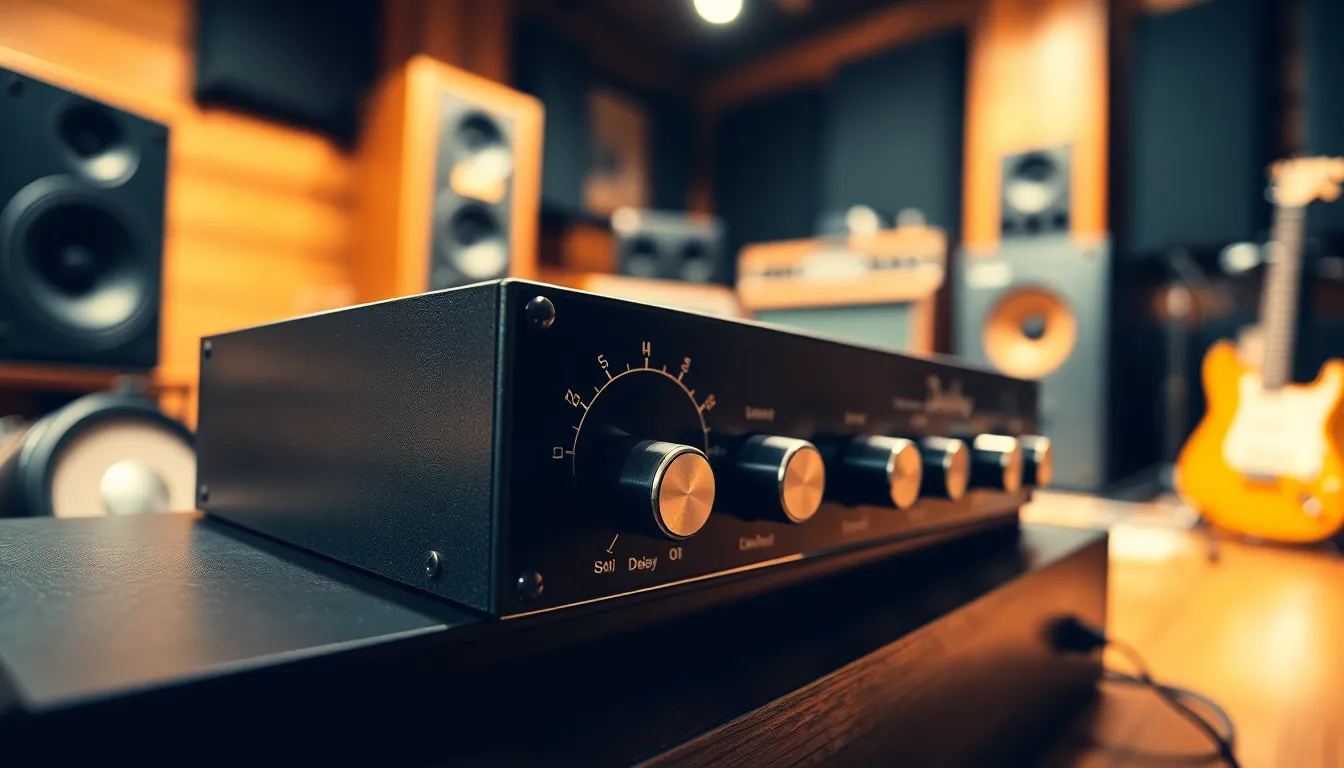Imagine you’re in a world where every sound has its own personality. Enter delay and echo units, the unsung heroes of audio production that transform mere noise into a symphony of creativity. These magical devices can take a simple guitar riff or a vocal line and stretch it into a sonic tapestry that dances through the air, leaving listeners wondering if they’ve just stepped into a musical wonderland or a sci-fi movie.
Table of Contents
ToggleOverview of Delay and Echo Units
Delay and echo units play a vital role in audio production. These devices manipulate sound waves, allowing artists to create unique auditory experiences.
Delay units store audio signals temporarily and then reproduce them at set intervals, generating rhythmic effects. Musicians often use delay to build complexity in their songs, enriching the listening experience.
Echo units, a variation of delay, extend the time between repetitions while emphasizing spatial characteristics. By reflecting sound, they mimic how audio travels through environments, adding depth to recordings.
Both delay and echo effects can be adjusted for various parameters, including time, feedback, and mix levels. Changes in these settings impact how pronounced the effects feel in a track.
Artists utilize delay to craft intricate soundscapes. For instance, a guitar solo can gain texture through rhythmic delays, while echo can transform a vocal line, making it resonate throughout a piece.
Delay and echo units significantly enhance the overall production. They enrich sound, enabling creativity and innovation in music. These tools not only elevate compositions but also engage listeners effectively.
Types of Delay and Echo Units

Delay and echo units come in various types, each offering unique features and applications in audio production.
Analog Delay Units
Analog delay units utilize tape or bucket brigade devices for sound processing. These units create warm, organic sounds, often appreciated for their rich tonal qualities. Artists frequently choose analog models for their character, which adds warmth to vocals or instruments. The feedback and modulation controls in these units allow for creative experimentation. Many musicians find themselves drawn to the lush textures that analog delays provide, enhancing tracks with a vintage feel.
Digital Delay Units
Digital delay units employ digital processing to replicate and manipulate sound waves. These units deliver precise control over delay times and feedback levels, allowing for intricate sound design. Musicians often prefer digital models for their versatility and reliability in live performances. With features like tap tempo and multi-tap configurations, users can create complex rhythmic patterns. The clarity and precision of digital echo effects can elevate any mix, making these units essential tools in contemporary music production.
Key Features to Consider
Understanding key features of delay and echo units ensures the best choice for audio production needs. Pay attention to sound quality, user interface, and connectivity options.
Sound Quality
Consider sound quality as a critical factor in selecting delay and echo units. Analog models typically provide warm, organic tones that many musicians appreciate. They excel in creating a rich sonic character that enhances musicality. Digital units, on the other hand, produce precise and clear audio. Artists often favor digital options for their versatility in live settings. Each unit’s ability to manage feedback and modulation contributes significantly to the overall sound. Inspecting these characteristics ensures optimal sonic results.
User Interface
Evaluate user interface design to improve user experience with delay and echo units. An intuitive layout allows quick adjustments during performances. Look for devices with clear labeling and well-positioned controls. Complex options, such as multiple delay taps or modulation settings, should remain easy to navigate. A responsive interface enhances the creative process. Musicians benefit from units that incorporate visual elements like displays or LED indicators, providing real-time feedback during use.
Connectivity Options
Connectivity options influence overall versatility in delay and echo units. Many devices offer various input and output configurations to suit different setups. Check for compatibility with instruments and recording systems, including MIDI and USB connections. Multiple outputs can facilitate integration with other audio gear, such as mixers or effects processors. Flexibility in connectivity enables seamless performance and recording experiences. Selecting units equipped with diverse options maximizes potential for creative exploration.
Popular Delay and Echo Units on the Market
Several delay and echo units stand out for their features and performance. These devices cater to various needs in audio production.
Unit 1 Review
The BOSS DD-200 offers versatility with its compact design and extensive features. Producing high-quality sounds, it includes 12 different delay modes, ranging from standard to complex effects. Musicians appreciate the user-friendly interface, allowing quick adjustments. Additionally, features like tap tempo and MIDI in/out enhance performance convenience.
Unit 2 Review
The Electro-Harmonix Memory Man is revered for its warm analog tones, reminiscent of vintage equipment. It incorporates unique modulation options, allowing users to create lush soundscapes. Beyond its straightforward controls, this unit provides a rich feedback loop, enabling creative experimentation. Many users find its simplicity paired with sonic depth appealing for both studio and live settings.
Unit 3 Review
The Strymon Timeline excels in flexibility and precision, featuring 12 unique delay types. This unit accommodates complex setups with MIDI and expression pedal connectivity. Clarity in sound design is notable, with options for tweaking delay time and feedback. Users benefit from the ability to save preset configurations, streamlining performance transitions.
Delay and echo units are vital tools in the world of audio production. They not only enhance sound but also allow artists to explore their creativity in new ways. By understanding the unique features of both analog and digital models, musicians can select the right units that suit their style and needs.
Whether it’s the warmth of an analog delay or the precision of a digital unit, these devices help craft immersive sonic landscapes. As artists continue to push the boundaries of music, delay and echo units will remain essential in creating captivating auditory experiences that resonate with listeners.




